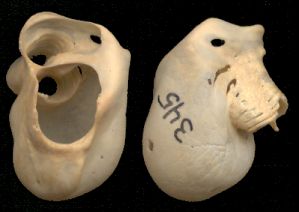

Listening to the musical shenanigans of a Mockingbird is almost enough to make your throat sore. Just think what that must be doing to that poor bird's vocal chords! Goes to show, though, that misconceptions occur easily when we assume that other animals are like us—because birds don't use vocal chords to produce their repertoire.
Instead, a uniquely avian organ is used—the syrinx. In most, this is an enlargement at the junction of the windpipe and the two bronchi formed by the splitting of the windpipe. In some, only the windpipe or only the bronchi are involved. Varying widely, the more complex include up to nine pairs of muscles that, together with variations in the amount and pressure of air, produce the marvelous sounds. Indeed, some birds are able to sing unrelated notes simultaneously by separately controlling two bronchial syringes.
So, next time you hear a Mockingbird, perhaps you should be amazed, not
at its song, but at the fact that people can produce such a variety of sounds with
decidedly inferior equipment.

Contributor: Arthur H. Harris, Laboratory for Environmental Biology, Centennial Museum, University of Texas at El Paso.
Desert Diary is a joint production of the Centennial Museum and KTEP National Public Radio at the University of Texas at El Paso.

The bony portion of the syrinx of a male Pintail Duck (Anas acuta). On the left, a view down the "windpipe" clearly shows the division into the two bronchi. The right-hand view shows the structure from the side. Scanned images by A.H. Harris; UTEP Ornithology specimen.
Welty, J. C. 1982. The life of birds. 3rd ed., Saunders College Publishing, Philadelphia. 754 pp.
Bird Songs; PBS' Life of Birds.